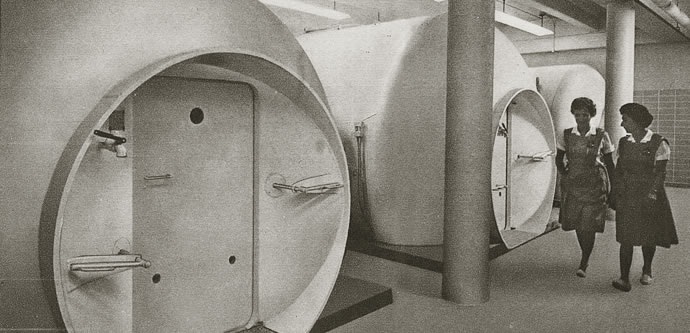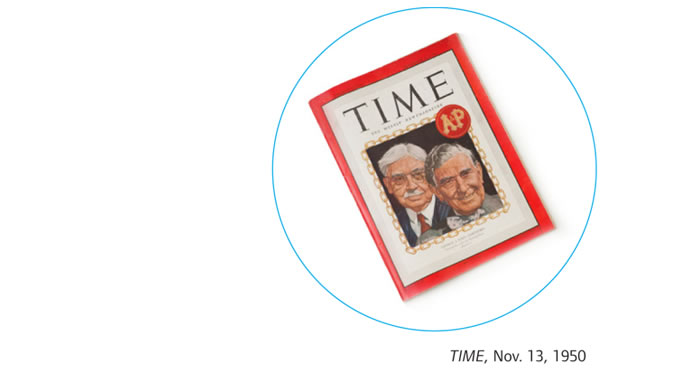2012 ANNUAL REPORT
Early History of the John A. Hartford Foundation (1929-1978)
John A. Hartford was President of the Great Atlantic and Pacific Tea Co., known later as the A&P supermarkets. Throughout the early 20th century, he and his brother George L. Hartford, A&P’s Chairman, transformed their father’s small grocery chain into a behemoth enterprise, pioneering modern consumer experiences such as large chain stores and store-brand products.
In 1929, the A&P grocery chain became the largest retailer in the world, achieving $1 billion in annual sales—the first retail merchant ever to reach this milestone. In the same year, John A. Hartford established the Foundation that bears his name. At first, it served as Hartford’s personal vehicle for charitable giving to churches, relief agencies, and hospitals.
After the brothers’ deaths in the 1950s, A&P stock contributions from their estates made the Hartford Foundation the fourth largest philanthropy in the country. The Foundation Trustees then embarked on an ambitious course of funding biomedical research, guided by John Hartford’s request that it strive always to “do the greatest good for the greatest number.” The Foundation became the largest private, not-for-profit supporter of clinical research in the United States, playing a role the federal government would eventually take on with the National Institutes of Health.
The Hartford Foundation funding brought about important advances in modern medicine, including pioneering technologies and treatment innovations for organ transplantation, kidney dialysis, heart disease, non-invasive cataract surgery, and cancer, among others.
By the 1970s, A&P stock declined in value. That meant the Foundation had less money at a time when advances in technology made funding medical research increasingly expensive. Meanwhile, the National Institutes of Health had begun supporting medical research on a scale that dwarfed the contributions of foundations, diminishing the influence of private funding.
 (Above ) Early grants from the Hartford Foundation funded innovative medical advances, including kidney transplantation, cardiac resuscitation, non-invasive cataract surgery, hyperbaric chambers (above), a left ventricular assist device (a partial artificial heart), and laser eye surgery, among others.
(Above ) Early grants from the Hartford Foundation funded innovative medical advances, including kidney transplantation, cardiac resuscitation, non-invasive cataract surgery, hyperbaric chambers (above), a left ventricular assist device (a partial artificial heart), and laser eye surgery, among others.
The Hartford Foundation began to wind down its biomedical research projects in the late 1970s and investigated new areas of giving where it could have the most impact possible. For its last effort in biomedical research, the Foundation inaugurated the John A. and George L. Hartford Fellowship Program in 1979 to promote the career development of young physicians and encourage more of them to embark on research careers. One notable recipient was the young investigator Francis S. Collins, MD, PhD, who received funding to pursue his genetics research. Dr. Collins later led the Human Genome Project and is currently director of the National Institutes of Health.
As the Trustees considered new interest areas, they kept in mind a piece of advice John Hartford had handed down: “It is necessary to carve from the whole vast spectrum of human needs one small band that the heart and mind together tell you is the area in which you can make your best contribution.”
Because of the Foundation’s long history of supporting groundbreaking work in medicine, the Trustees believed that health care remained the arena in which the Foundation could make its best contribution. Two health program areas ultimately prevailed. In 1979, the Foundation began its Health Care Cost and Quality program, and in 1982, the Foundation launched the Aging and Health program—its current and only focus.
 “One great foundation in America, early and almost alone, heavily supported the investigation and development of the principle on which microneurosurgery has been built. No one involved in microneurosurgery today has not profited from that investment. The Foundation sought no glory and has received none... but, nonetheless, is entitled to our silent gratitude.”
Raymond M.P. Donaghy, MD
“One great foundation in America, early and almost alone, heavily supported the investigation and development of the principle on which microneurosurgery has been built. No one involved in microneurosurgery today has not profited from that investment. The Foundation sought no glory and has received none... but, nonetheless, is entitled to our silent gratitude.”
Raymond M.P. Donaghy, MDDirector of Neurological Research
Medical Center Hospital of Vermont
Professor Emeritus of Neurosurgery
College of Medicine
University of Vermont